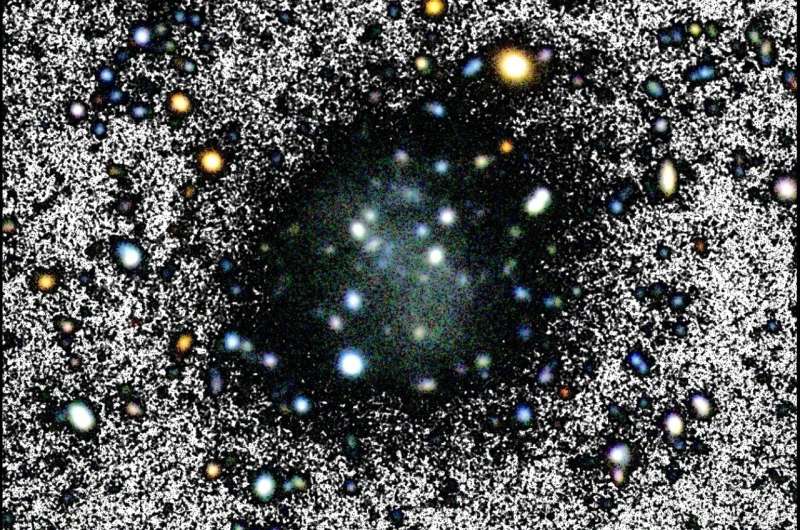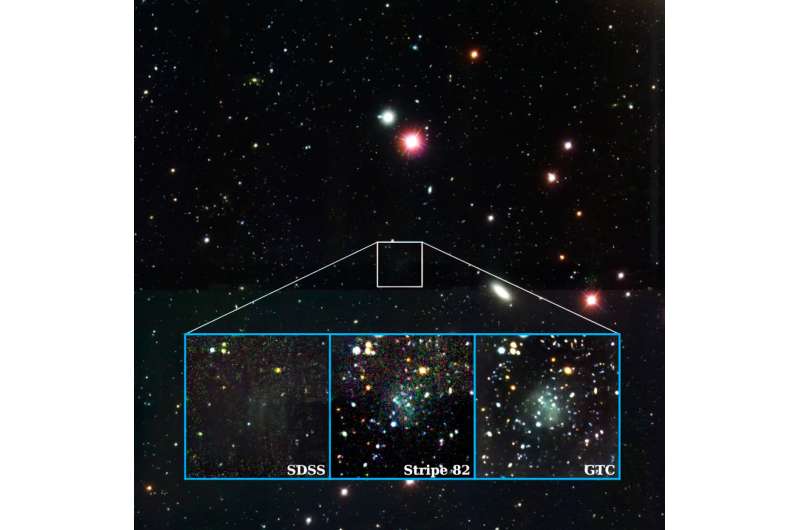Nube galaxy challenges dark matter model
- January 10, 2024
- 0
Nube is a nearly invisible dwarf galaxy discovered by an international research team led by the Canary Islands Institute for Astrophysics (IAC) in collaboration with the University of
Nube is a nearly invisible dwarf galaxy discovered by an international research team led by the Canary Islands Institute for Astrophysics (IAC) in collaboration with the University of

Nube is a nearly invisible dwarf galaxy discovered by an international research team led by the Canary Islands Institute for Astrophysics (IAC) in collaboration with the University of La Laguna (ULL) and other institutions. The name, suggested by the 5-year-old daughter of one of the researchers in the group, relates to the messy appearance of the object. The surface brightness is so faint that it had gone unnoticed in various previous studies of this part of the sky due to the object’s diffuse appearance, as if it were some kind of ghost. This is because its stars are spread over such a large volume that it is almost impossible to notice the “Nube” (“Cloud” in Spanish).
This newly discovered galaxy has a number of specific features that distinguish it from previously known objects. The research team estimated that Nube is a dwarf galaxy that is 10 times fainter than other objects of its type, but also 10 times more massive than other objects with the same number of stars. To illustrate what this means to someone with some knowledge of astronomy, this galaxy is one-third the size of the Milky Way but has a mass similar to that of the Small Magellanic Cloud.
“With our current knowledge, we do not understand how a galaxy with such extreme properties could exist,” explains Mireia Montes, first author of the paper and a researcher at IAC and ULL.
The paper’s second author, Ignacio Trujillo, had been analyzing Sloan Digital Sky Survey (SDSS) images of a particular strip of sky for several years as part of the Legado del IAC Stripe 82 project. a weak point that seems interesting enough to start a research project. The next step was to use ultra-deep, multicolor images from the Gran Telescopio Canarias (GTC) to confirm that this patch in the survey was not an error but an extremely diffuse object. It is difficult to determine the exact distance to Nube due to its dimness.
Using observations obtained with the Green Bank Telescope (GBT) in the United States, the authors estimated the distance to Nube to be 300 million light-years; but future observations were made with the Very Large Array (VLA) radio telescope and the William Herschel Optical Telescope (WHT at the Roque de los Muchachos observatory in La Palma will assist them in demonstrating whether this distance is correct.
“If the galaxy turns out to be closer, it will still be a very strange object and will create serious problems for astrophysics,” comments Ignacio Trujillo.

Another problem for the modern dark matter model?
The general rule is that galaxies have a much higher density of stars in their inner regions, and this density decreases rapidly with distance from the center. But at Nube, Montes says, “the star density varies very little across the object, which is why it’s so faint and we couldn’t observe it well until we got ultra-deep images from GTC.” “
Nube surprised astronomers. The team explains that, at first glance, there was no interaction or other indication of its strange properties. Cosmological simulations cannot reproduce its “extreme” features, even if based on different scenarios. “We are left without a valid explanation within the currently accepted cosmological model of cold dark matter,” explains Montes.
The cold dark matter model can reproduce large-scale structures in the universe, but there are small-scale scenarios, such as the Nube case, for which it cannot provide a good answer. We have shown how various theoretical models fail to produce this, making it one of the most extreme cases known so far.
Montes comments: “With this galaxy and similar galaxies we have been able to find, it is possible to find additional clues that will open a new window to our understanding of the universe.”
“One attractive possibility is that Nube’s unusual properties show us that the particles that make up dark matter have extremely low mass,” says Ignacio Trujillo. If this were the case, the unusual properties of this galaxy would exhibit properties of quantum physics, but on a galactic scale. “If this hypothesis is confirmed, it will be one of nature’s most beautiful displays that will unite the world of the smallest with the world of the largest,” he concludes.
Source: Port Altele
As an experienced journalist and author, Mary has been reporting on the latest news and trends for over 5 years. With a passion for uncovering the stories behind the headlines, Mary has earned a reputation as a trusted voice in the world of journalism. Her writing style is insightful, engaging and thought-provoking, as she takes a deep dive into the most pressing issues of our time.